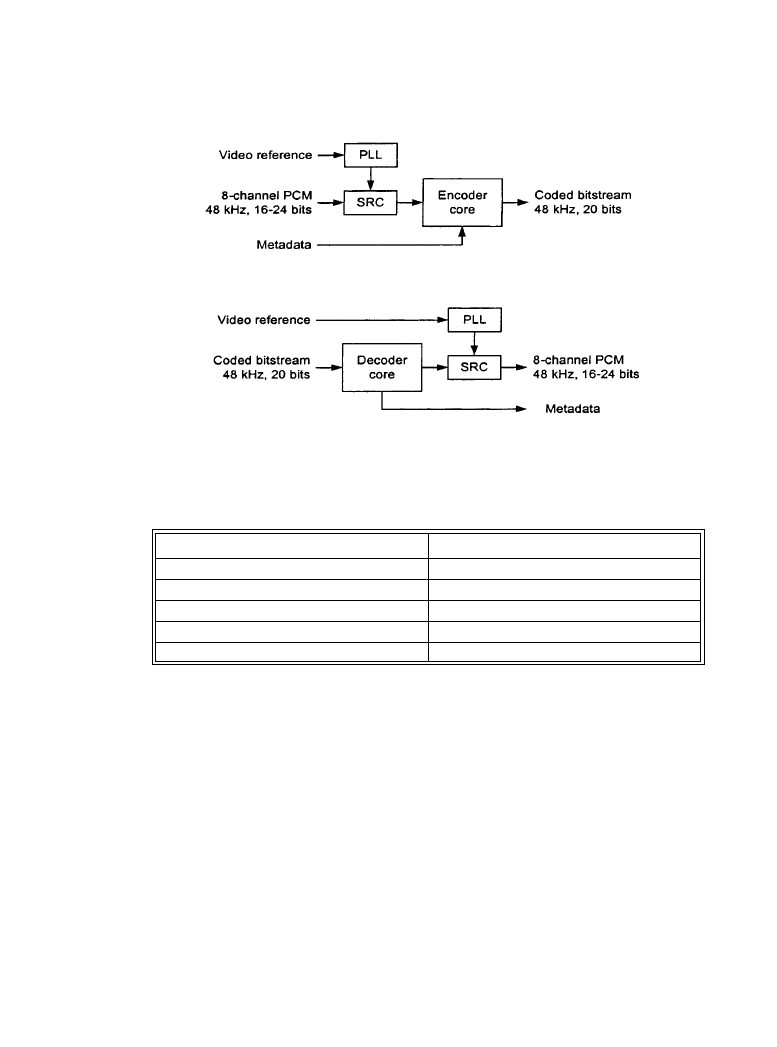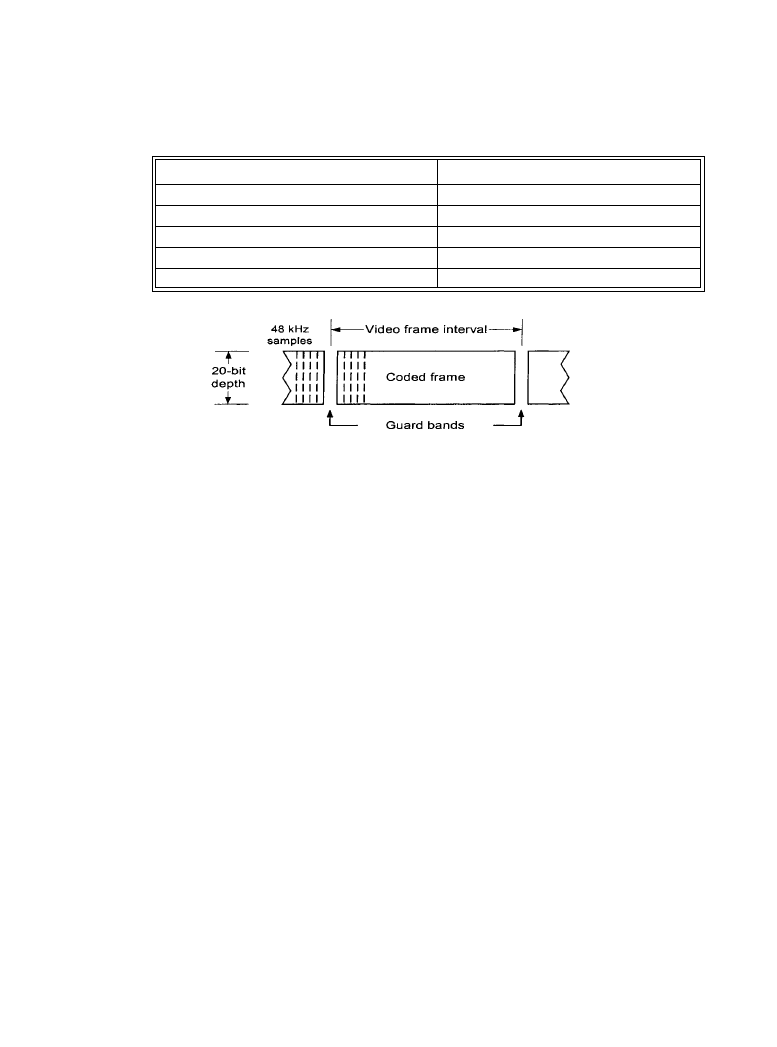ВУЗ: Казахская Национальная Академия Искусств им. Т. Жургенова
Категория: Книга
Дисциплина: Не указана
Добавлен: 03.02.2019
Просмотров: 21709
Скачиваний: 19

7-26 Compression Technologies for Audio
As shown in Figure 7.1.11, not all of the output channel data rate is used for carrying coded
audio. Instead, gaps of about 5 percent of the total frame duration are introduced between succes-
sive audio frames. These gaps act as switching guard bands, providing a measure of tolerance for
real-time splicing and editing of coded bitstreams without concern for damaging adjacent frame
data.
7.1.3
Objective Quality Measurements
Perceptual audio coding has revolutionized the processing and distribution of digital audio sig-
nals. One aspect of this technology, not often emphasized, is the difficulty of determining, objec-
tively, the quality of perceptually coded signals. Audio professionals could greatly benefit from
Table 7.1.2 PCM Sample Count as a Function of Video Frame Rate
(
After [7].)
Frame Rate (f/s)
Samples per Frame
23.98
2002
24
2000
25
1920
29.97
1601.6
30
1600
(
a)
(
b)
Figure 7.1.10
Dolby E architecture: (
a) encoder, (b) decoder. (After [6].)
Downloaded from Digital Engineering Library @ McGraw-Hill (www.digitalengineeringlibrary.com)
Copyright © 2004 The McGraw-Hill Companies. All rights reserved.
Any use is subject to the Terms of Use as given at the website.
Audio Compression Systems

Audio Compression Systems 7-27
an objective approach to signal characterization because it would offer a simple but accurate
approach for verification of good audio quality within a given facility.
Most of the discussions regarding this topic involve reference to the results of subjective eval-
uations of audio quality, where for example, groups of listeners compare reference audio mate-
rial to coded audio material and then judge the level of impairment caused by the coding process.
A procedure for this process has been standardized in ITU-R Rec. BS.1116, and makes use of the
ITU-R five grade impairment scale:
•
5.0—Imperceptible
•
4.0—Perceptible but not annoying
•
3.0—Slightly annoying
•
2.0—Annoying
•
10—Very annoying
Quality measurements made with properly executed subjective evaluations are widely
accepted and have been used for a variety of purposes, from determining which of a group of
perceptual coders performs best, to assessing the overall performance of an audio broadcasting
system.
The problem with subjective evaluations is that, while accurate, they are time consuming and
expensive to undertake. Traditional objective benchmarks of audio performance, such as signal-
to-noise ratio or total harmonic distortion, are not reliable measures of perceived audio quality,
especially when perceptually coded signals are being considered.
To remedy this situation, ITU-R established Task Group 10-4 to develop a method of objec-
tively assessing perceived audio quality. Conceptually, the result of this effort would be a device
Table 7.1.3: Internal Sample Rate as a Function of Video Frame Rate
(
After [7].)
Frame Rate (f/s)
Internal Sample Rate (kHz)
23.98
42.965
24
43.008
25
44.800
29.97
53.706
30
53.760
Figure 7.1.11
Dolby E coded frame format. (
After [6].)
Downloaded from Digital Engineering Library @ McGraw-Hill (www.digitalengineeringlibrary.com)
Copyright © 2004 The McGraw-Hill Companies. All rights reserved.
Any use is subject to the Terms of Use as given at the website.
Audio Compression Systems

7-28 Compression Technologies for Audio
having two inputs—a reference and the audio signal to be evaluated—and would generate an
audio quality estimate based on these sources.
Six organizations proposed models for accomplishing this objective, and over the course of
several years these models were evaluated for effectiveness, in part by using source material from
previously documented subjective evaluations. Ultimately, the task group decided that none of
the models by themselves fully met the stated requirements. The group decided, instead, to use
the best parts of the different models to create another model that would meet the sought-after
requirements.
This approach resulted in an objective measurement method known as Perceptual Evaluation
of Audio Quality (PEAQ). The method contains two versions—a basic version designed to sup-
port real-time implementations, and an advanced version optimized for the highest accuracy but
not necessarily implementable in real-time. The primary applications for PEAQ are summarized
in Table 7.1.4.
7.1.3a
Perspective on Audio Compression
A balance must be struck between the degree of compression available and the level of distortion
that can be tolerated, whether the result of a single coding pass or the result of a number of
passes, as would be experienced in a complex audio chain or network [1]. There have been many
outstanding successes for digital audio data compression in communications and storage, and as
long as the limitations of the various compression systems are fully understood, successful
implementations will continue to grow in number. Table 7.1.5 compares several common audio
coding systems.
Compression is a tradeoff and in the end you get what you pay for. Quality must be measured
against the coding algorithm being used, the compression ratio, bit rate, and coding delay result-
ing from the process.
There is continued progress in expanding the arithmetical capabilities of digital signal proces-
sors, and the supporting hardware developments would seem to be following a parallel course. It
is possible to obtain a single chip containing both encoder and decoder elements, including ste-
Table 7.1.4 Target Applications for ITU-R Rec. BS.1116 PEAQ
Category
Application
Version
Diagnostic
Assessment of implementations Both
Equipment or connection status
Advanced
Codec identification
Both
Operational
Perceptual quality line-up
Basic
On-line monitoring
Basic
Development
Codec development
Both
Network planning
Both
Aid to subjective assessment
Advanced
Downloaded from Digital Engineering Library @ McGraw-Hill (www.digitalengineeringlibrary.com)
Copyright © 2004 The McGraw-Hill Companies. All rights reserved.
Any use is subject to the Terms of Use as given at the website.
Audio Compression Systems

Audio Compression Systems 7-29
reo capabilities. In every five year period, it is not unreasonable to expect a tenfold increase in
the processing capabilities of a single DSP chip, thus, increasing flexibility and processing
power. Speculation could point to an eventual position when a completely lossless algorithm
with an extremely high compression ratio would become available. In any event, the art of com-
pressing audio data streams into narrower and narrower digital pipes will undoubtedly continue.
7.1.4
References
1.
Wylie, Fred: “Audio Compression Technologies,” NAB Engineering Handbook, 9th ed.,
Jerry C. Whitaker (ed.), National Association of Broadcasters, Washington, D.C., 1998.
2.
Wylie, Fred: “Audio Compression Techniques,” The Electronics Handbook, Jerry C. Whi-
taker (ed.), CRC Press, Boca Raton, Fla., pp. 1260–1272, 1996.
3.
Herre, J., and B. Grill: “MPEG-4 Audio—Overview and Perspectives for the Broadcaster,”
IBC 2000 Proceedings, International Broadcast Convention, Amsterdam, September 2000.
4.
Lyman, Stephen, “A Multichannel Audio Infrastructure Based on Dolby E Coding,” Pro-
ceedings of the NAB Broadcast Engineering Conference, National Association of Broad-
casters, Washington, D.C., 1999.
5.
Terry, K. B., and S. B. Lyman: “Dolby E—A New Audio Distribution Format for Digital
Broadcast Applications,” International Broadcasting Convention Proceedings, IBC, Lon-
don, England, pp. 204–209, September 1999.
Table 7.1.5 Comparison of Audio Compression Coding Systems
(
After [7].)
Audio System
Total Bit Rates
(kbits/s)
Filter Bank
Frequency
Resolution
@48 kHz
Temporal
Resolution
@48 kHz (ms)
Frame
Length
@48 kHz
(ms)
Bit Rate Target
(kbits/s per
channel)
MPEG Layer I
32–448
PQMF
750 Hz
0.66
8
128
MPEG Layer II
32–384
PQMF
750 Hz
0.66
24
128
MPEG Layer III
32–320
PQMF/MDCT
41.66 Hz
4
24
64
apt-X
Fixed 4:1
compression
1
PQMF
12 kHz
<0.1
2.54
192
apt-Q
Fixed 12:1 and
18:1
compression
2
MDCT
23.44 Hz
5.34
42.66
64
AC-3
32–640 MDCT
93.75
Hz
2.66
32
64
1 Bit rates are from 56 to 384 kbits/s when the sampling frequency varies from 16 to 48 kHz.
2 Bit rates can vary from 56 kbits/s for a mono signal sampled at 32 kHz to 128 kbits/s for a stereo signal sampled
at 48 kHz.
Downloaded from Digital Engineering Library @ McGraw-Hill (www.digitalengineeringlibrary.com)
Copyright © 2004 The McGraw-Hill Companies. All rights reserved.
Any use is subject to the Terms of Use as given at the website.
Audio Compression Systems

7-30 Compression Technologies for Audio
6.
Vernon, S., and T. Spath: “Carrying Multichannel Audio in a Stereo Production and Distri-
bution Infrastructure,” Proceedings of IBC 2000, International Broadcasting Convention,
Amsterdam, September 2000.
7.
Robin, Michael, and Michel Poulin: Digital Television Fundamentals, McGraw-Hill, New
York, N.Y., 1998.
7.1.5
Bibliography
Brandenburg, K., and Gerhard Stoll: “ISO-MPEG-1 Audio: A Generic Standard for Coding of
High Quality Digital Audio,” 92nd AES Convention Proceedings, Audio Engineering Soci-
ety, New York, N.Y., 1992, revised 1994.
Smyth, Stephen: “Digital Audio Data Compression,” Broadcast Engineering, Intertec Publish-
ing, Overland Park, Kan., February 1992.
Downloaded from Digital Engineering Library @ McGraw-Hill (www.digitalengineeringlibrary.com)
Copyright © 2004 The McGraw-Hill Companies. All rights reserved.
Any use is subject to the Terms of Use as given at the website.
Audio Compression Systems